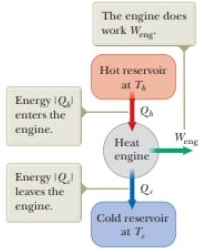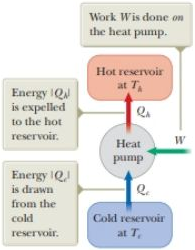
PHYSICS:F/SCI.+ENGRS.,V.1
10th Edition
ISBN: 9781337553575
Author: SERWAY
Publisher: CENGAGE L
expand_more
expand_more
format_list_bulleted
Textbook Question
Chapter 21, Problem 9P
If a 35.0% -efficient Carnot
Figure P21.2 Schematic representation of a heat engine.

Figure P21.4 Schematic representation of a heat pump.

Expert Solution & Answer
Trending nowThis is a popular solution!

Students have asked these similar questions
Make sure to draw a sketch and a free body diagram. DO NOT give me examples but ONLY the solution
Make sure to draw a sketch AND draw a Free body diagram
P
-3 ft
3 ft.
O
A
B
1.5 ft
Do
1.5 ft
✓
For the frame and loading shown, determine the magnitude of the reaction at C (in
lb) if P = 55 lb. (Hint: Use the special cases: Two-force body and Three-force body.)
Chapter 21 Solutions
PHYSICS:F/SCI.+ENGRS.,V.1
Ch. 21.1 - The energy input to an engine is 4.00 times...Ch. 21.2 - The energy entering an electric heater by...Ch. 21.4 - Three engines operate between reservoirs separated...Ch. 21.6 - (a) Suppose you select four cards at random from a...Ch. 21.7 - An ideal gas is taken from an initial temperature...Ch. 21.7 - True or False: The entropy change in an adiabatic...Ch. 21 - A particular heat engine has a mechanical power...Ch. 21 - The work done by an engine equals one-fourth the...Ch. 21 - Suppose a heat engine is connected to two energy...Ch. 21 - During each cycle, a refrigerator ejects 625 kJ of...
Ch. 21 - A freezer has a coefficient of performance of...Ch. 21 - A heat pump has a coefficient of performance equal...Ch. 21 - One of the most efficient heat engines ever built...Ch. 21 - Why is the following situation impossible? An...Ch. 21 - If a 35.0% -efficient Carnot heat engine (Fig....Ch. 21 - An ideal refrigerator or ideal heat pump is...Ch. 21 - A heat engine is being designed to have a Carnot...Ch. 21 - A power plant operates at a 32.0% efficiency...Ch. 21 - You are working on a summer job at a company that...Ch. 21 - A Carnot heat engine operates between temperatures...Ch. 21 - An electric generating station is designed to have...Ch. 21 - Suppose you build a two-engine device with the...Ch. 21 - A heat pump used for heating shown in Figure...Ch. 21 - A gasoline engine has a compression ratio of 6.00....Ch. 21 - An idealized diesel engine operates in a cycle...Ch. 21 - (a) Prepare a table like Table 21.1 for the...Ch. 21 - Prob. 21PCh. 21 - A Styrofoam cup holding 125 g of hot water at 100C...Ch. 21 - A 1 500-kg car is moving at 20.0 m/s. The driver...Ch. 21 - A 2.00-L container has a center partition that...Ch. 21 - Calculate the change in entropy of 250 g of water...Ch. 21 - What change in entropy occurs when a 27.9-g ice...Ch. 21 - When an aluminum bar is connected between a hot...Ch. 21 - When a metal bar is connected between a hot...Ch. 21 - How fast are you personally making the entropy of...Ch. 21 - Prob. 30APCh. 21 - The energy absorbed by an engine is three times...Ch. 21 - In 1993, the U.S. government instituted a...Ch. 21 - In 1816, Robert Stirling, a Scottish clergyman,...Ch. 21 - Suppose an ideal (Carnot) heat pump could be...Ch. 21 - Review. This problem complements Problem 44 in...Ch. 21 - A firebox is at 750 K, and the ambient temperature...Ch. 21 - A 1.00-mol sample of an ideal monatomic gas is...Ch. 21 - A system consisting of n moles of an ideal gas...Ch. 21 - A heat engine operates between two reservoirs at...Ch. 21 - You are working as an assistant to a physics...Ch. 21 - Prob. 41APCh. 21 - You are working as an expert witness for an...Ch. 21 - An athlete whose mass is 70.0 kg drinks 16.0...Ch. 21 - Prob. 44APCh. 21 - Prob. 45APCh. 21 - A sample consisting of n moles of an ideal gas...Ch. 21 - The compression ratio of an Otto cycle as shown in...
Knowledge Booster
Learn more about
Need a deep-dive on the concept behind this application? Look no further. Learn more about this topic, physics and related others by exploring similar questions and additional content below.Similar questions
- A convex mirror (f.=-6.20cm) and a concave minor (f2=8.10 cm) distance of 15.5cm are facing each other and are separated by a An object is placed between the mirrors and is 7.8cm from each mirror. Consider the light from the object that reflects first from the convex mirror and then from the concave mirror. What is the distance of the image (dia) produced by the concave mirror? cm.arrow_forwardAn amusement park spherical mirror shows park spherical mirror shows anyone who stands 2.80m in front of it an upright image one and a half times the person's height. What is the focal length of the minor? m.arrow_forwardAn m = 69.0-kg person running at an initial speed of v = 4.50 m/s jumps onto an M = 138-kg cart initially at rest (figure below). The person slides on the cart's top surface and finally comes to rest relative to the cart. The coefficient of kinetic friction between the person and the cart is 0.440. Friction between the cart and ground can be ignored. (Let the positive direction be to the right.) m M (a) Find the final velocity of the person and cart relative to the ground. (Indicate the direction with the sign of your answer.) m/s (b) Find the friction force acting on the person while he is sliding across the top surface of the cart. (Indicate the direction with the sign of your answer.) N (c) How long does the friction force act on the person? S (d) Find the change in momentum of the person. (Indicate the direction with the sign of your answer.) N.S Find the change in momentum of the cart. (Indicate the direction with the sign of your answer.) N.S (e) Determine the displacement of the…arrow_forward
- Small ice cubes, each of mass 5.60 g, slide down a frictionless track in a steady stream, as shown in the figure below. Starting from rest, each cube moves down through a net vertical distance of h = 1.50 m and leaves the bottom end of the track at an angle of 40.0° above the horizontal. At the highest point of its subsequent trajectory, the cube strikes a vertical wall and rebounds with half the speed it had upon impact. If 10 cubes strike the wall per second, what average force is exerted upon the wall? N ---direction--- ▾ ---direction--- to the top to the bottom to the left to the right 1.50 m 40.0°arrow_forwardThe magnitude of the net force exerted in the x direction on a 3.00-kg particle varies in time as shown in the figure below. F(N) 4 3 A 2 t(s) 1 2 3 45 (a) Find the impulse of the force over the 5.00-s time interval. == N⚫s (b) Find the final velocity the particle attains if it is originally at rest. m/s (c) Find its final velocity if its original velocity is -3.50 î m/s. V₁ m/s (d) Find the average force exerted on the particle for the time interval between 0 and 5.00 s. = avg Narrow_forward••63 SSM www In the circuit of Fig. 27-65, 8 = 1.2 kV, C = 6.5 µF, R₁ S R₂ R3 800 C H R₁ = R₂ = R3 = 0.73 MQ. With C completely uncharged, switch S is suddenly closed (at t = 0). At t = 0, what are (a) current i̟ in resistor 1, (b) current 2 in resistor 2, and (c) current i3 in resistor 3? At t = ∞o (that is, after many time constants), what are (d) i₁, (e) i₂, and (f) iz? What is the potential difference V2 across resistor 2 at (g) t = 0 and (h) t = ∞o? (i) Sketch V2 versus t between these two extreme times. Figure 27-65 Problem 63.arrow_forward
- Thor flies by spinning his hammer really fast from a leather strap at the end of the handle, letting go, then grabbing it and having it pull him. If Thor wants to reach escape velocity (velocity needed to leave Earth’s atmosphere), he will need the linear velocity of the center of mass of the hammer to be 11,200 m/s. Thor's escape velocity is 33532.9 rad/s, the angular velocity is 8055.5 rad/s^2. While the hammer is spinning at its maximum speed what impossibly large tension does the leather strap, which the hammer is spinning by, exert when the hammer is at its lowest point? the hammer has a total mass of 20.0kg.arrow_forwardIf the room’s radius is 16.2 m, at what minimum linear speed does Quicksilver need to run to stay on the walls without sliding down? Assume the coefficient of friction between Quicksilver and the wall is 0.236.arrow_forwardIn the comics Thor flies by spinning his hammer really fast from a leather strap at the end of the handle, letting go, then grabbing it and having it pull him. If Thor wants to reach escape velocity (velocity needed to leave Earth’s atmosphere), he will need the linear velocity of the center of mass of the hammer to be 11,200 m/s. A) If the distance from the end of the strap to the center of the hammer is 0.334 m, what angular velocity does Thor need to spin his hammer at to reach escape velocity? b) If the hammer starts from rest what angular acceleration does Thor need to reach that angular velocity in 4.16 s? c) While the hammer is spinning at its maximum speed what impossibly large tension does the leather strap, which the hammer is spinning by, exert when the hammer is at its lowest point? The hammer has a total mass of 20.0kg.arrow_forward
- The car goes from driving straight to spinning at 10.6 rev/min in 0.257 s with a radius of 12.2 m. The angular accleration is 4.28 rad/s^2. During this flip Barbie stays firmly seated in the car’s seat. Barbie has a mass of 58.0 kg, what is her normal force at the top of the loop?arrow_forwardConsider a hoop of radius R and mass M rolling without slipping. Which form of kinetic energy is larger, translational or rotational?arrow_forwardA roller-coaster vehicle has a mass of 571 kg when fully loaded with passengers (see figure). A) If the vehicle has a speed of 22.5 m/s at point A, what is the force of the track on the vehicle at this point? B) What is the maximum speed the vehicle can have at point B, in order for gravity to hold it on the track?arrow_forward
arrow_back_ios
SEE MORE QUESTIONS
arrow_forward_ios
Recommended textbooks for you
 Principles of Physics: A Calculus-Based TextPhysicsISBN:9781133104261Author:Raymond A. Serway, John W. JewettPublisher:Cengage Learning
Principles of Physics: A Calculus-Based TextPhysicsISBN:9781133104261Author:Raymond A. Serway, John W. JewettPublisher:Cengage Learning Physics for Scientists and EngineersPhysicsISBN:9781337553278Author:Raymond A. Serway, John W. JewettPublisher:Cengage Learning
Physics for Scientists and EngineersPhysicsISBN:9781337553278Author:Raymond A. Serway, John W. JewettPublisher:Cengage Learning Physics for Scientists and Engineers with Modern ...PhysicsISBN:9781337553292Author:Raymond A. Serway, John W. JewettPublisher:Cengage Learning
Physics for Scientists and Engineers with Modern ...PhysicsISBN:9781337553292Author:Raymond A. Serway, John W. JewettPublisher:Cengage Learning Physics for Scientists and Engineers: Foundations...PhysicsISBN:9781133939146Author:Katz, Debora M.Publisher:Cengage Learning
Physics for Scientists and Engineers: Foundations...PhysicsISBN:9781133939146Author:Katz, Debora M.Publisher:Cengage Learning College PhysicsPhysicsISBN:9781938168000Author:Paul Peter Urone, Roger HinrichsPublisher:OpenStax College
College PhysicsPhysicsISBN:9781938168000Author:Paul Peter Urone, Roger HinrichsPublisher:OpenStax College

Principles of Physics: A Calculus-Based Text
Physics
ISBN:9781133104261
Author:Raymond A. Serway, John W. Jewett
Publisher:Cengage Learning

Physics for Scientists and Engineers
Physics
ISBN:9781337553278
Author:Raymond A. Serway, John W. Jewett
Publisher:Cengage Learning

Physics for Scientists and Engineers with Modern ...
Physics
ISBN:9781337553292
Author:Raymond A. Serway, John W. Jewett
Publisher:Cengage Learning

Physics for Scientists and Engineers: Foundations...
Physics
ISBN:9781133939146
Author:Katz, Debora M.
Publisher:Cengage Learning

College Physics
Physics
ISBN:9781938168000
Author:Paul Peter Urone, Roger Hinrichs
Publisher:OpenStax College

The Second Law of Thermodynamics: Heat Flow, Entropy, and Microstates; Author: Professor Dave Explains;https://www.youtube.com/watch?v=MrwW4w2nAMc;License: Standard YouTube License, CC-BY